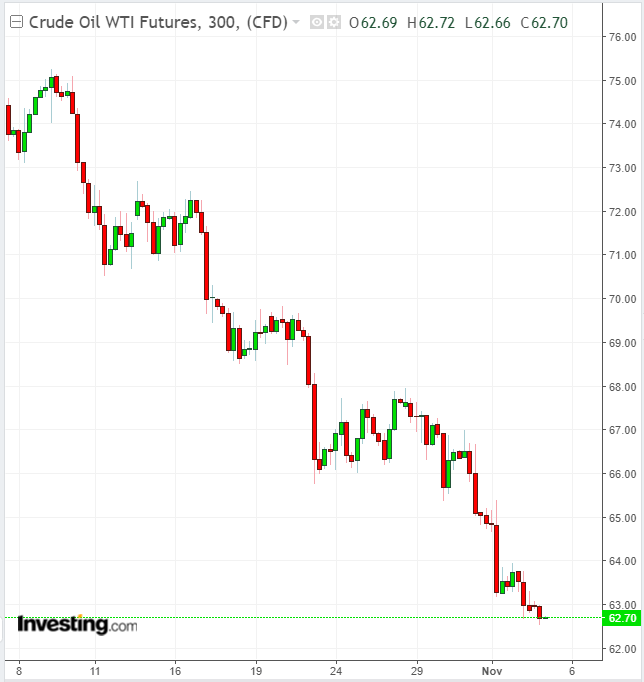Will oil bears get to call the bluff on Iranian sanctions as they’ve wagered? The waiting game is up for Donald Trump’s bid to put a freeze on the world’s fourth largest oil exporter.
Along with the start of the US-imposed embargo on Iran, this week will likely bring more volatility in gold and other commodities as the dollar stays flighty on relatively strong US economic data versus the protracted trade war with China and nervous trading on Wall Street. Further impacting the dollar will be the Federal Reserve’s monthly meeting on Thursday. While a rate hike isn’t expected until December, the Fed’s policy statement will be scanned for language that could influence the greenback.
Oil Prices Could Slump Further
Trading in oil will be particularly rocky.

Without imminent proof of market tightness from the Iranian sanctions, some think US West Texas Intermediate (WTI) crude could break below $60 a barrel and U.K. Brent under $70. On Friday, WTI settled at $63.14 while Brent, the global benchmark for crude, closed at $72.83. Both moved lower this morning to start the trading week.
Since Trump canceled an Obama-era deal in May that allowed Tehran oil shipments in exchange for curbs on its nuclear program, oil markets have experienced extreme volatility, surging almost 20 percent over five months before whipsawing and giving all that back in less than five weeks.
The about-face was triggered by several catalysts. Chief among them, however, was the president’s own need to keep oil prices low ahead of US midterm elections this Tuesday.
Saudi Arabia, mired in crisis since October for alleged complicity in the sensational murder of journalist Jamal Khashoggi, also fell in line with Trump’s wishes, agreeing to pump as much as necessary to fill the void left by Iran’s average export of 2 million barrels per day. US shale crude output, meanwhile, hit record highs, threatening another global oil glut.
The last shoe to drop for oil bulls was the Trump Administration’s issuance on Friday of waivers to eight countries—India, Japan, South Korea and China among them—allowing each nation to continue buying at least some crude from Iran. on grounds that finding quick alternatives wouldn’t be easy. The Islamic Republic and the EU have also been finding workarounds to the sanctions.
Market “Very Relaxed” On Iran; Selloff Overdone?
“Most market participants remain very relaxed that there will be no supply or logistics issues in the short- to medium-term,” Dominick Chirichella, director of trading and risk at the Energy Management Institute in New York, said after hedge funds slashed their net bullish holdings in WTI last week to the lowest in a year. Some, including Goldman Sach), urge caution, saying Brent could be back to $80 by December.
“The granting of waivers does not imply that Iran exports will stabilize near current levels. We still expect that the global oil market will be in deficit in 4Q18,” said the Wall Street bank, one of the most influential voices in energy markets.
TD Securities concurred, saying the waivers on Iran were only likely to be temporary:
“The amounts were expected for the most part and Europe will not receive any, thus we expect these sanctions will indeed tighten the market and the extent of the recent selloff has been overdone.”
Gold In Focus On US Elections, China and Equities
Gold, particularly, will be on investors’ radar after an adrenalin-charged week, during which it lost 2 percent over the first three days, then won all that back on the fourth before conceding some in the last session to finish with fifth straight week of gains.

US gold futures for February settled on Friday at $1,233.30 a troy ounce and could take a crack at the $1,270 level if the commodity price gets past the $1,246 resistance this week, technical charts show. Like oil, the gold market is being shaped somewhat by the US midterm elections, with some seeing the precious metal as a hedge against a possible Congressional victory by Democrats. That could cause a major setback to Trump and his Republican party.
Investors could also see bullion as a store of value if equity markets revert to October’s nerve-wracking trends, where the Dow lost 5 percent, in its worst tumble in nearly three years. US stocks did rise 2.3 percent last week but they remain vulnerable to any hint that Trump’s talks regarding a trade deal with China’s leader Xi Jinpeng at the upcoming G20 summit in Buenos Aires could be scrapped.
“I think those are the main things that will get us to the next price level—a weak Wall Street and the US-China rhetoric,” said Tom Beller, market strategist for precious metals analysts at RJO Futures in Chicago.
